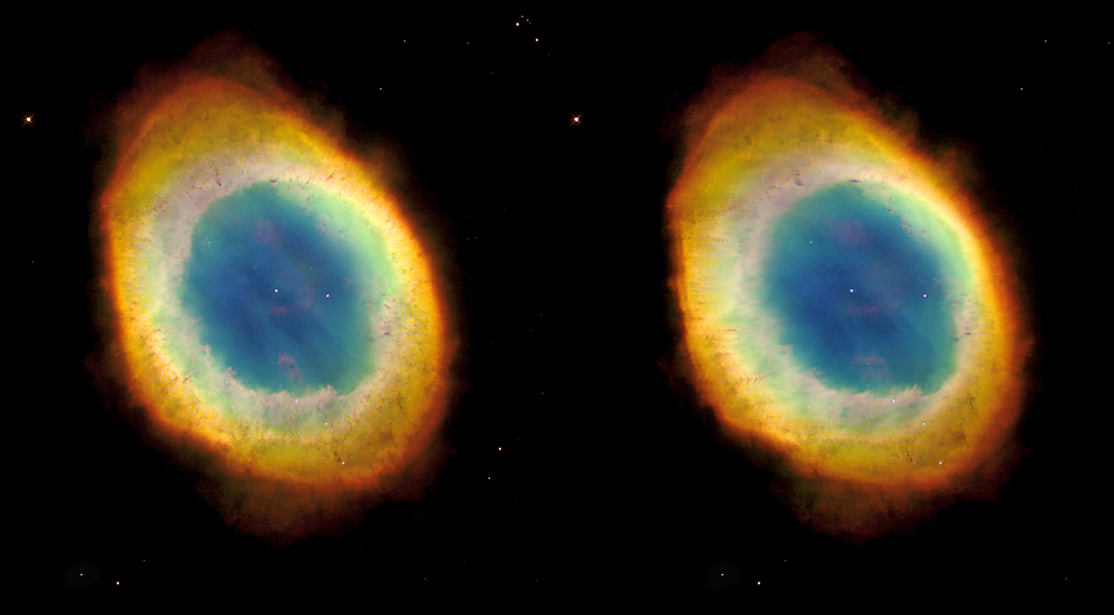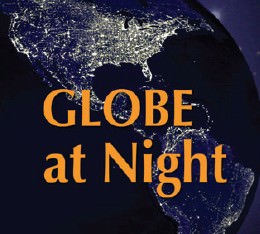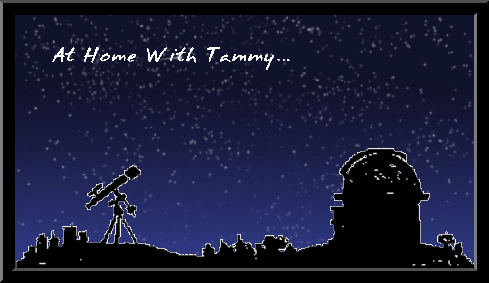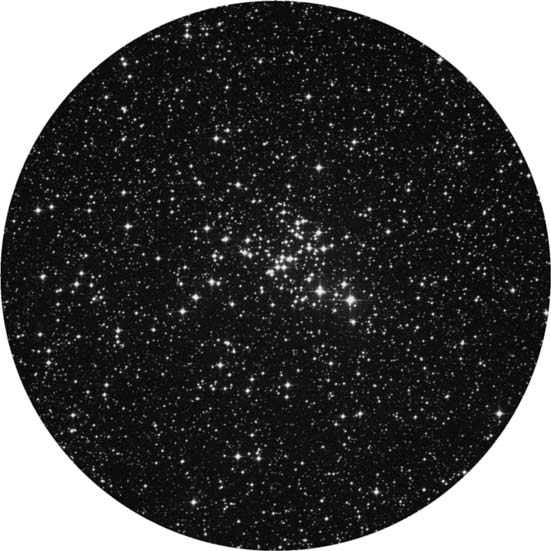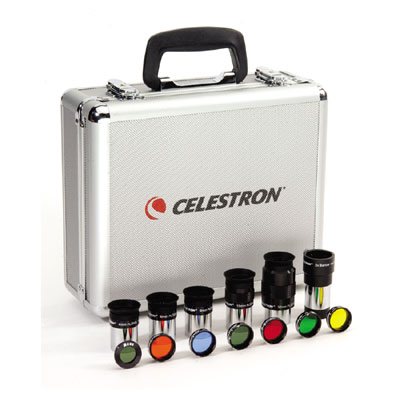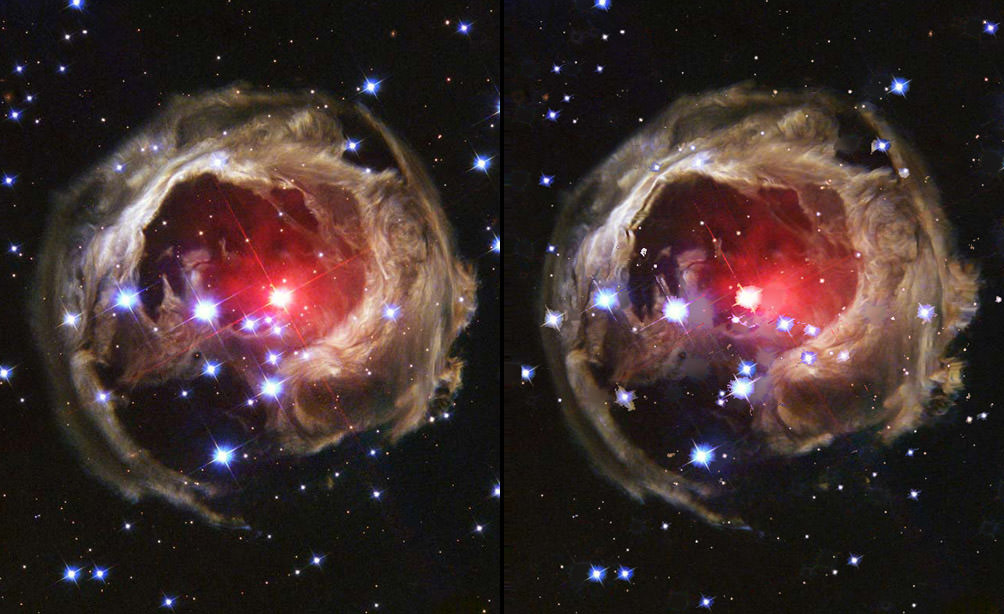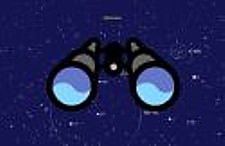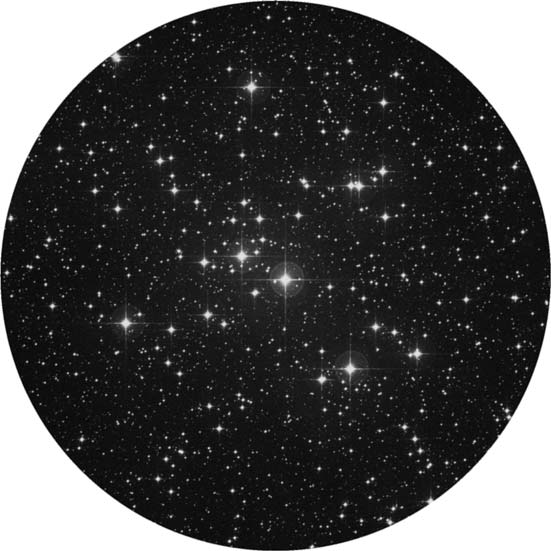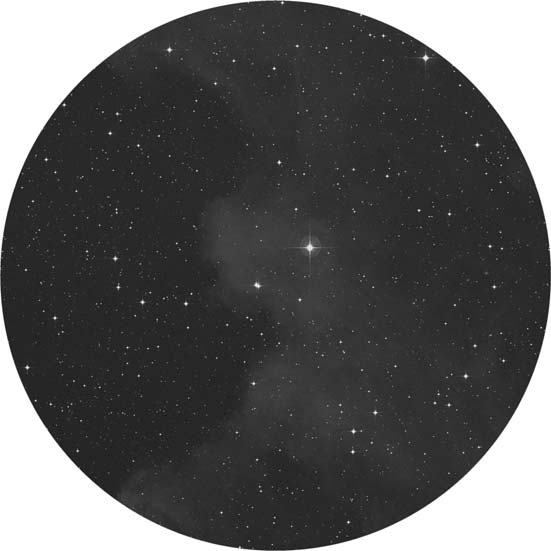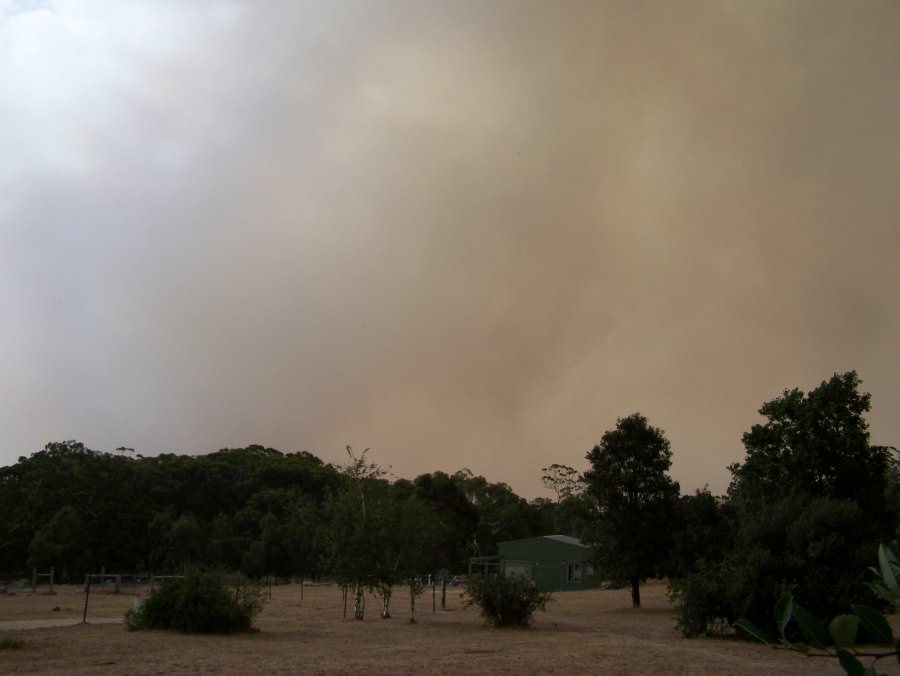Roughly 38 million miles from Earth and traveling at a relative velocity of 140,000 miles per hour, the speedy Comet C/2007 N3 Lulin has caught our imaginations in a big way during the beginning months of the International Year of Astronomy. Right now, Comet Lulin has already sped past the Sun, slipped by stately Saturn from our point of view and is on a parabolic trajectory heading out from our solar system. This means it will never come back… Continue reading “Comet Lulin Video – Watch the Outgassing Process”
Tunnel Vision – Step Into the “Ring”…
[/caption]
Who doesn’t recognize this awesome image of Messier Object 57 which was taken by the Hubble Space Telescope? The original color image was assembled from three black-and-white photos taken through different color filters with the Hubble’s Wide Field Planetary Camera 2. We know the blue filtration isolates emission from very hot helium, which is located primarily close to the hot central star… just as green represents the further away ionized oxygen and cool red shows ionized nitrogen gas at the farthest position of all. We know where they’re supposed to be, but we’ve never quite seen it in dimension until it’s been visualized by the “magic” of Jukka Metsavainio…
Like all our our “stereo” image produced for UT by Jukka Metsavainio, two versions are presented here. The one above is parallel vision – where you relax your eyes and when you are a certain distance from the monitor screen the two images will merge into one to produce a 3D version. I have heard from a friend recently that if you place a card in the center of the image with the edge towards you, it aids in seeing the parallel version. (And he was right.) The second – which appears below – is crossed vision. This is for those who have better success crossing their eyes to form a third, central image where the dimensional effect occurs. (The card “trick” also works well here, too!) Jukka’s visualizations of what Hubble images would look like if we were able to see them in dimension come from studying the object, its known field star distances and the different wavelengths of light. Are you ready to “cross” the boundary and step into the “Ring” for another round with Messier 57? Then let’s rock…
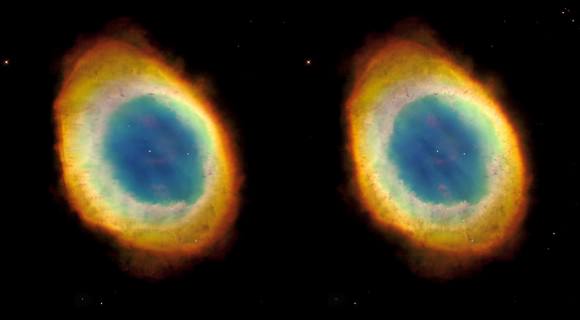
Originally discovered by discovered by Antoine Darquier de Pellepoix in January, 1779 and independently found by Charles Messier later that same month, it was Darquier who first said that it was “…as large as Jupiter and resembles a planet which is fading.” Thanks to his description, the term ” planetary nebula” stuck because of their similarity in appearance to giant planets when viewed through small optical telescopes. However, Sir William Herschel wasn’t quite so aperture limited, and he was the first to propose this new object was a nebula was formed by multiple faint stars. By 1800, Count Friedrich von Hahn had discovered M57’s central star and within 64 years William Huggins was studying its spectral signature. Just a blink of a cosmic eye later, another 22 years, Hungarian astronomer Jen? Gothard had discovered it had a planetary nebula nucleus.
What has remained constant over the years is the classic bipolar structure associated with the “Ring” nebula – a prolate spheroid with strong concentrations of material along its equator. Its symmetrical structure is one of the best known in the night sky – right down to the knots along the edges that can often be observed with larger telescopes. What exactly are they? According to C.R. O’Dell (et al); ” The equator of the Ring Nebula is optically thick and much denser than the optically thin poles. The inner halo surrounding NGC 6720 represents the pole-on projection of the AGB wind at high latitudes (circumpolar) directly ionized by the central star, whereas the outer, fainter, and circular halo is the projection of the recombining AGB wind at mean to low latitudes, shadowed by the main nebula. The spatio-kinematical properties of the Ring Nebula and the origin of the dense knots commonly observed in late-stage planetary nebulae are critically compared with the predictions of radiation-hydrodynamic and wind interaction models.”
These winds, bubbles and explosions were part of the original Hubble photograph where our visualization came from. “We have studied the closest bright planetary nebulae with the Hubble Space Telescope’s WFPC2 in order to characterize the dense knots already known to exist in NGC 7293.” says O’Dell, “We find knots in all of the objects, arguing that knots are common, simply not always observed because of distance. The knots appear to form early in the life cycle of the nebula, probably being formed by an instability mechanism operating at the nebula’s ionization front. As the front passes through the knots they are exposed to the photoionizing radiation field of the central star, causing them to be modified in their appearance. This would then explain as evolution the difference of appearance like the lacy filaments seen only in extinction in IC 4406 on the one extreme and the highly symmetric “cometary” knots seen in NGC 7293. The intermediate form knots seen in NGC 2392, NGC 6720, and NGC 6853 would then represent intermediate phases of this evolution.”
Anyone who is willing to step into the ring with this champion of all planetary nebulae is liable to end up with a few knots somewhere! Enjoy your tunnel vision journey….
GLOBE at Night 2009 – Can You See the Stars?
Turning out the lights for “Earth Hour” is going to be a great way to demonstrate caring about climate changes by turning off the lights – but what about the impact that light pollution has on our skies? 2008 marked a monumental shift in human history when the number of people living in cities exceeded half the people on Earth. Because of the ambient light of urban landscapes, many city dwellers have never seen a sky full of stars. Are you interested in helping science study the impact of lighting in your area? Then step inside and learn more about GLOBE…
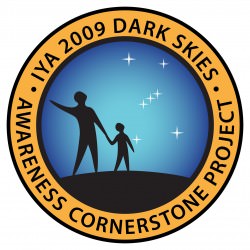 GLOBE at Night is a wonderful way for everyone around the world to participate as a citizen-sciencist to raise public awareness of the impact of artificial lighting on local environments. This event encourages everyone – students, educators, dark sky advocates and the general public – to measure the darkness of their local skies and contribute their observations online to a world map. GLOBE at Night is a centerpiece of the Dark Skies Awareness Global Cornerstone Project for the International Year of Astronomy (IYA) in 2009, and we need people – just like you – to get involved! Data collection and online reporting is simple and user-friendly.
GLOBE at Night is a wonderful way for everyone around the world to participate as a citizen-sciencist to raise public awareness of the impact of artificial lighting on local environments. This event encourages everyone – students, educators, dark sky advocates and the general public – to measure the darkness of their local skies and contribute their observations online to a world map. GLOBE at Night is a centerpiece of the Dark Skies Awareness Global Cornerstone Project for the International Year of Astronomy (IYA) in 2009, and we need people – just like you – to get involved! Data collection and online reporting is simple and user-friendly.
 Led by the educational outreach staff at the National Optical Astronomy Observatory and the University Corporation for Atmospheric Research GLOBE Program, the GLOBE at Night campaign will take place for a 4th year from March 16-28, 2009. “The geographic reach of the GLOBE at Night program exceeded our wildest expectations,” said Connie Walker, an astronomer and science education specialist at the National Optical Astronomy Observatory (NOAO), one of the event’s major co-sponsors. “We fell a few hundred short of our target of 5,000 total observations, but the engagement and excitement of large family groups, and dozens of school children participating in the activity together, more than make up for a few less data points.”
Led by the educational outreach staff at the National Optical Astronomy Observatory and the University Corporation for Atmospheric Research GLOBE Program, the GLOBE at Night campaign will take place for a 4th year from March 16-28, 2009. “The geographic reach of the GLOBE at Night program exceeded our wildest expectations,” said Connie Walker, an astronomer and science education specialist at the National Optical Astronomy Observatory (NOAO), one of the event’s major co-sponsors. “We fell a few hundred short of our target of 5,000 total observations, but the engagement and excitement of large family groups, and dozens of school children participating in the activity together, more than make up for a few less data points.”
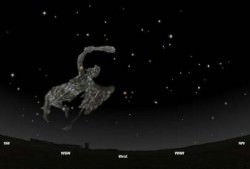 Over the past 3 years, tens of thousands of citizen-scientists around the world have contributed measurements of their local sky brightness to a growing global database in two ways: simple unaided-eye observations toward the constellation Orion and quantative digital measurements through a handheld, well-calibrated sky-brightness meter. For the first method, citizen-scientists take data on light pollution levels by comparing what they see toward Orion, with star maps showing different stellar brightness limits. The basic idea is to look for the faintest stars and match them to one of seven star maps of progressively fainter limiting magnitudes. For the second method, digital sky-brightness meters are used for more precise measurements. The low-cost digital Sky Quality Meters (SQMs), manufactured by Unihedron, can make a highly repeatable, direct measurement of integrated sky brightness. The newly available second-generation of SQM-Ls being used this year by several GLOBE at Night sites has a cone-shaped “field of view” that is three times more narrow than the older model. This specifically aids its use in city environments, where surrounding lights or buildings may affect the readings.
Over the past 3 years, tens of thousands of citizen-scientists around the world have contributed measurements of their local sky brightness to a growing global database in two ways: simple unaided-eye observations toward the constellation Orion and quantative digital measurements through a handheld, well-calibrated sky-brightness meter. For the first method, citizen-scientists take data on light pollution levels by comparing what they see toward Orion, with star maps showing different stellar brightness limits. The basic idea is to look for the faintest stars and match them to one of seven star maps of progressively fainter limiting magnitudes. For the second method, digital sky-brightness meters are used for more precise measurements. The low-cost digital Sky Quality Meters (SQMs), manufactured by Unihedron, can make a highly repeatable, direct measurement of integrated sky brightness. The newly available second-generation of SQM-Ls being used this year by several GLOBE at Night sites has a cone-shaped “field of view” that is three times more narrow than the older model. This specifically aids its use in city environments, where surrounding lights or buildings may affect the readings.
 To learn the five easy steps to participate in either type of GLOBE at Night program and to obtain important information on light pollution, stellar magnitudes, the mythology of Orion, how to find Orion, how to obtain your latitude and longitude, and how to use an SQM, see the GLOBE at Night website. No prior experience is necessary and all the information you need to participate is right there – along with downloads for activity kits for families, teachers and invididuals in six different languages. All observations will be available online via Google Earth and as downloadable datasets, too.
To learn the five easy steps to participate in either type of GLOBE at Night program and to obtain important information on light pollution, stellar magnitudes, the mythology of Orion, how to find Orion, how to obtain your latitude and longitude, and how to use an SQM, see the GLOBE at Night website. No prior experience is necessary and all the information you need to participate is right there – along with downloads for activity kits for families, teachers and invididuals in six different languages. All observations will be available online via Google Earth and as downloadable datasets, too.
Thanks to an international network of partners, GLOBE reaches people around the world, and during their first two years managed 20,000 observations from a total of 100 countries. This year, they’re hoping for an even greater success rate and within weeks of submitting your data, a world map showing the results of your studies will be made available. Using this information, you can then compare the data to previous studies, as well as satellite data and population density data. Collecting information from mulitple locations inside a single city or region is highly encourged, and would make a great class project or astronomy club activity!
By activity participating in projects like GLOBE, you can make difference. More measurements made each year and over the next few years will allow for in more depth analysis. More measurements within a city will provide maps of higher resolution and comparisons between years would allow people to monitor changes. Just like our other Earthly environments, monitoring our lighting environment will allow us as citizen-scientists to identify and preserve dark sky locations in cities or catch an area developing too quickly and influence people to make smart choices in lighting by providing them with informed neighbors. As just everyday, ordinary people, we can impact what happens by educating ourselves and others. If more and more people took a few minutes during the March 2009 campaign to measure sky brightness either toward Orion with the unaided-eye or toward zenith with a Sky Quality Meter (or both!), their measurements – and yours – will make a world of difference!
Many thanks to NOAO team members, Constance E. Walker, Douglas Isbell, Stephen M. Pompea, David A. Smith and Thomas R. Baker.
Earth Hour 2009 – Where Will You Be When The Lights Go Out?
With less than six weeks to go, more than 500 cities around the world have officially agreed to go dark in support of global action on climate change. On March 28, 2009 at 8:30 p.m., local time, World Wildlife Fund is asking individuals, businesses, governments and organizations around the world to turn off their lights for one hour — Earth Hour — to make a global statement of concern about climate change and to demonstrate their commitment to finding solutions. Step inside and find out how you can become a part of this historic event…
Wherever you happen to be in the world on March 28th at 8:30 p.m., you’re likely to find a city or community somewhere nearby that is making plans to turn out the lights for Earth Hour – a global goal of 1,000 cities! WWF’s initiative aims to increase awareness about climate change and demonstrate that people from all over the world care about the issue. “Climate change and what we do about it is going to transform the world much more rapidly than people realize.” say Richard Moss, Vice President and Managing Director for Climate Change. “It’s my goal to get us moving to a world we will want, not one we’ll regret leaving for our children and grandchildren.”
Before you start knocking “Earth Hour” as something that just won’t make a difference, take just a moment of your time and watch this, please…
And now, here are some highlights of what’s going on around Earth Hour 2009 as we count down the days…
NASHVILLE: Earth Hour launched in Music City with a musical press conference that included live performances by Nashville superstars pledging to turn out against climate change.
THE STARS AND STRIPES ARE ALIGNING: Houston, TX; Santa Rosa, CA; St Louis, MO; Sarasota, FL; Minneapolis, MN; and Valdosta, GA signed up to be part of Earth Hour 2009. They join Atlanta, Chicago, Dallas, Las Vegas, Los Angeles, Miami, Nashville, New York City and San Francisco.
NOBEL PEACE PRIZE WINNER ARCHBISHOP DESMOND TUTU ANNOUNCES HIS SUPPORT: “Climate change is the greatest human induced crisis facing the world today. It is totally indiscriminate of race, culture and religion. It affects every human being on the planet. Earth Hour is an opportunity for every man, woman and child from all corners of the globe to come together with a united voice and make a loud and powerful statement on the issue of climate change.”
BACK TO MY OLD SCHOOL: The University of Miami became the first American campus to officially sign up to turn off, but was quickly joined by Michigan State, University of Nevada, Las Vegas, University of Virginia, Belmont, Columbia, Ohio University, Howard University, Georgia Tech, Northwestern, Spellman, University of Missouri, St. Louis and Vanderbilt.
I GOT THE POWER: 10,000 college students from across the nation will converge on Washington DC on February 27–March 2 for Power Shift ’09, asking for “bold, comprehensive and immediate federal climate action.” Earth Hour Project Director Meg Pearce and Campus Organizer Sophie Latham will be there holding a special session on how to be part of Earth Hour 2009, the largest global climate event in history.
CITY OF LIGHTS TO TURN LIGHTS OFF IN SUPPORT OF WWF’S EARTH HOUR 2009: Paris—known as the City of Lights—will lead a list of 28 cities and towns across France that have committed to join the world in making a visual vote for decisive action on climate change by turning off their lights for one hour during Earth Hour 2009 on March 28th.
LAS VEGAS FLICKS THE SWITCH FOR EARTH HOUR 2009: Officials from World Wildlife Fund joined Clark County, Nevada Commissioner Lawrence Weekly, City of Las Vegas Mayor Oscar B. Goodman and City of Henderson Mayor James B. Gibson at the iconic “Welcome to Fabulous Las Vegas” sign to officially kick off the Las Vegas Valley’s participation in Earth Hour–a global event calling for action on climate change.
For now? Be sure to visit the Earth Hour website, where you can sign up to show your support and find all kinds of wonderful tools and ideas on how to motivate your community, school, family and friends to pledge just one hour of their time to darkness and become part of this global event.
Don’t forget to mark your calendar…Earth Hour is March 28, 2009, at 8:30 pm. Be there with us when the lights go out…
Weekend SkyWatcher’s Forecast – February 20-22, 2009
Greetings, fellow SkyWatchers! Are you ready for one awesome weekend? Then let’s enjoy the dark skies as we take on a wide variety of challenges. For those who just use their eyes, this is a great time to spot Venus, Saturn, Jupiter and the New Moon in the Old Moon’s Arms. Need more? For binoculars we have open star clusters and bright comets. Still more? Then get out your telescope and dust off your eyepieces and let’s see how good you are as we take on some challenges! Whenever you’re ready, I’ll see you in the back yard….
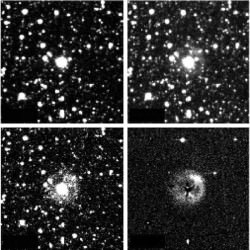 Friday, February 20, 2009 – On this date in 1962, John Glenn was rocketing around Earth on his first orbit as our friends ‘‘down under’’ made history. Residents of Perth, Australia, simultaneously switched on lights as Glenn flew over—the first city spotted from space! If you’re out tonight as the Sun sets, be sure to take a look along the western horizon for the first bright “star” to appear. That’s not a star – that’s Venus! Today in 1996 also marks the discovery of Sakurai’s Object, a star in collapse.While studying Sagittarius and photographing what appeared to be a typical nova, Yukio Sakurai became only the third twentieth-century astronomer to witness a star in final helium flash. When this occurs, the star is switching its nuclear fuel from hydrogen to helium and then burning the helium to carbon in the final stage, burping forth an envelope from its interior.
Friday, February 20, 2009 – On this date in 1962, John Glenn was rocketing around Earth on his first orbit as our friends ‘‘down under’’ made history. Residents of Perth, Australia, simultaneously switched on lights as Glenn flew over—the first city spotted from space! If you’re out tonight as the Sun sets, be sure to take a look along the western horizon for the first bright “star” to appear. That’s not a star – that’s Venus! Today in 1996 also marks the discovery of Sakurai’s Object, a star in collapse.While studying Sagittarius and photographing what appeared to be a typical nova, Yukio Sakurai became only the third twentieth-century astronomer to witness a star in final helium flash. When this occurs, the star is switching its nuclear fuel from hydrogen to helium and then burning the helium to carbon in the final stage, burping forth an envelope from its interior.
Let’s examine an open cluster where stars have gone through this same evolutionary step. Begin by identifying Delta Geminorum and hop a fist-width east for open cluster NGC 2420 (RA 07 38 23 Dec +21 34 24). This magnitude 8.5 group is visible under dark-sky conditions to binoculars as a weak, round, hazy patch and requires a mid-sized telescope to begin resolution of its long, looping chains of stars.
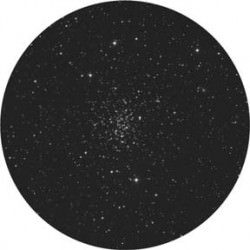 Some members are similar to Sakurai’s Object, while others have evolved to helium depletion. Studying clusters like NGC 2420 is important: they are areas where stars are all about the same age, yet their different masses mean they evolve at different rates. Average telescopes will only see the primary stars, while large aperture notices the distinct glow of hundreds of stars on the verge of resolution. If you get the impression of a weak globular cluster, you’d be correct. With a thousand members packed into a
Some members are similar to Sakurai’s Object, while others have evolved to helium depletion. Studying clusters like NGC 2420 is important: they are areas where stars are all about the same age, yet their different masses mean they evolve at different rates. Average telescopes will only see the primary stars, while large aperture notices the distinct glow of hundreds of stars on the verge of resolution. If you get the impression of a weak globular cluster, you’d be correct. With a thousand members packed into a
30-light-year sphere, a lot has happened during its 1.7-billion-year lifetime. It may have started in our own galaxy’s cluster-forming region and been thrown clear by an encounter with a large mass. Or, it might have once been part of a smaller galaxy absorbed by our own. But one thing is clear: its unusual Sun-like elements—so far from where they belong—make NGC 2420 a prime playground for study. Some of its members could even be blue stragglers—unions of two stars into one!
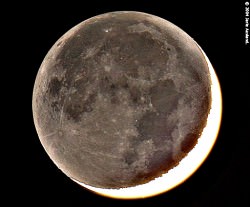 Saturday, February 21, 2009 – This day in 1972, Luna 20 made a safe touchdown in the Apollonius highlands, where it captured 30 grams of surface material to return to Earth. The Moon will make a very scenic appearance in the pre-dawn skies and be visible for several hours after the Sun rises. Take time to show others its position as you walk to work or school, and explain its movement away from the Sun from our viewpoint. How long does the Moon remain visible as the sky brightens? This pretty visage is often called the “New Moon in the Old Moon’s Arms”.
Saturday, February 21, 2009 – This day in 1972, Luna 20 made a safe touchdown in the Apollonius highlands, where it captured 30 grams of surface material to return to Earth. The Moon will make a very scenic appearance in the pre-dawn skies and be visible for several hours after the Sun rises. Take time to show others its position as you walk to work or school, and explain its movement away from the Sun from our viewpoint. How long does the Moon remain visible as the sky brightens? This pretty visage is often called the “New Moon in the Old Moon’s Arms”.
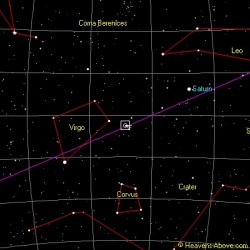 Got comet? Well, why the heck not? If you thought Comet Lulin was easy to find a week ago, it’s even easier to find now. The chart you see here was generated for position for the morning of Friday, February 20th – and Lulin will continue its course towards a future rendezvous with Saturn on Monday, February 23rd. With almost no Moon to contend with in the early morning sky (and if you get up early enough, you can easily observe before the Moon rises), 6th magnitude C/2007 N3 is so close to being visible to the unaided eye that even the smallest of binoculars will pick this elongated round fuzzy right out of the sky. Don’t wait until it meets up with Saturn to take a look at this 38 million mile traveler from the Oort Cloud – instead, try tracking it for several days. Lulin is sufficiently bright enough to been seen even from an urban setting and the bright “guide posts” of Spica and Saturn are easy markers.
Got comet? Well, why the heck not? If you thought Comet Lulin was easy to find a week ago, it’s even easier to find now. The chart you see here was generated for position for the morning of Friday, February 20th – and Lulin will continue its course towards a future rendezvous with Saturn on Monday, February 23rd. With almost no Moon to contend with in the early morning sky (and if you get up early enough, you can easily observe before the Moon rises), 6th magnitude C/2007 N3 is so close to being visible to the unaided eye that even the smallest of binoculars will pick this elongated round fuzzy right out of the sky. Don’t wait until it meets up with Saturn to take a look at this 38 million mile traveler from the Oort Cloud – instead, try tracking it for several days. Lulin is sufficiently bright enough to been seen even from an urban setting and the bright “guide posts” of Spica and Saturn are easy markers.
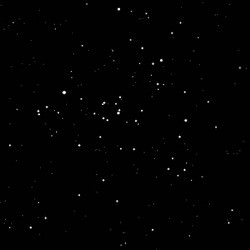 Tonight we’ll study an object of many names: Melotte 25, Collinder 50, and Caldwell 41, a star cluster so bright it doesn’t require a telescope. At 150 light-years away, the Hyades is the nearest gathering of stars to our Solar System that can be seen as a cluster. So, where is it? First, look at Aldebaran…
Tonight we’ll study an object of many names: Melotte 25, Collinder 50, and Caldwell 41, a star cluster so bright it doesn’t require a telescope. At 150 light-years away, the Hyades is the nearest gathering of stars to our Solar System that can be seen as a cluster. So, where is it? First, look at Aldebaran…
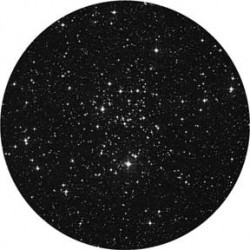 With the exception of this 60-light year-distant orange giant, almost all the stars around it are moving toward a point slightly east of Betelgeuse. The 790 million-year-old central mass spreads over a 10 light-year area, while outlying stars could stretch as far as 80 light-years. Aim binoculars its way and be blown away by a rich field of stars! Even with minimum magnification you’ll split the brightest member of the Hyades, the twin Sigma pair. They’ll appear close to the same magnitude and distance to the eye, but only the northernmost belongs to the Hyades moving cluster. Power up with a telescope. You’ll discover a wealth of other doubles and delightful color combinations in this much under-visited treat!
With the exception of this 60-light year-distant orange giant, almost all the stars around it are moving toward a point slightly east of Betelgeuse. The 790 million-year-old central mass spreads over a 10 light-year area, while outlying stars could stretch as far as 80 light-years. Aim binoculars its way and be blown away by a rich field of stars! Even with minimum magnification you’ll split the brightest member of the Hyades, the twin Sigma pair. They’ll appear close to the same magnitude and distance to the eye, but only the northernmost belongs to the Hyades moving cluster. Power up with a telescope. You’ll discover a wealth of other doubles and delightful color combinations in this much under-visited treat!
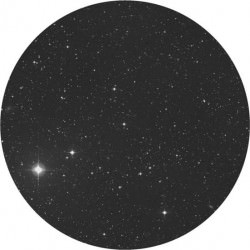 Now, I’ll appeal to the more advanced stargazer. Begin at the border of Orion and locate 8 Monoceros. We’re hunting for an odd star cluster called Dolidze 22 (RA 06 23 06 Dec +04 40 55). Although there’s no great scientific reason to observe this sparse open cluster, it’s an exercise aimed at sharpening your skills. To date, no data exist on the cluster’s true distance or age.
Now, I’ll appeal to the more advanced stargazer. Begin at the border of Orion and locate 8 Monoceros. We’re hunting for an odd star cluster called Dolidze 22 (RA 06 23 06 Dec +04 40 55). Although there’s no great scientific reason to observe this sparse open cluster, it’s an exercise aimed at sharpening your skills. To date, no data exist on the cluster’s true distance or age.
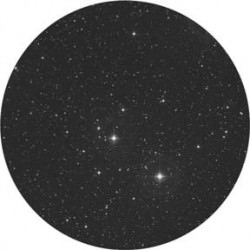 When you’ve noted your study, move about 2 degrees south and identify Collinder 91 (RA 06 21 42 Dec +02 22 00). Again, a loose, star-poor collection, essentially unstudied except for association. Why choose these two objects instead of brighter ones? Learning to visually understand a group relationship among stars is a skill Sir William Herschel had naturally, but one that can only be developed by most of us with a lot of practice. As Herschel once said:
When you’ve noted your study, move about 2 degrees south and identify Collinder 91 (RA 06 21 42 Dec +02 22 00). Again, a loose, star-poor collection, essentially unstudied except for association. Why choose these two objects instead of brighter ones? Learning to visually understand a group relationship among stars is a skill Sir William Herschel had naturally, but one that can only be developed by most of us with a lot of practice. As Herschel once said:
‘‘The phenomena of nature, especially those that fall under the inspection of the astronomer, are to be viewed not only with the usual attention to facts as they occur, but with the eye of reason and experience.’’
Sunday, February 22, 2009 – If you’re up before dawn, look for the relatively close pairing of the waning Moon and Jupiter. Try using the Moon’s position to see how long you can still spot the bright planet as the sky turns blue!
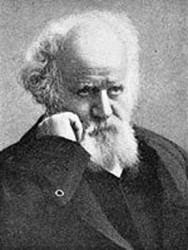 When the Sun has risen, salute the 1824 birth of Pierre Janssen, the first to devise a method for observing solar prominences. With a spectroscope, he proved the solar chromosphere is gaseous in nature and reported a helium spectral line. Janssen was also the first to record surface granulation via photography and published his own illustrated solar atlas in the year 1904.
When the Sun has risen, salute the 1824 birth of Pierre Janssen, the first to devise a method for observing solar prominences. With a spectroscope, he proved the solar chromosphere is gaseous in nature and reported a helium spectral line. Janssen was also the first to record surface granulation via photography and published his own illustrated solar atlas in the year 1904.
In 1966, Kosmos 110 launched its canine crew, Veterok and Ugolyok, into space history. Tonight let’s look at a celestial dog as we turn to Canis Minor. A large portion of the constellation is only viewable from the Southern Hemisphere, and most of its brighter stars hide below the horizon for the north. Look for an arch of four fairly bright stars to the east of Canis Major. The second from the east is Xi Puppis. Aim telescopes or binoculars just north of Xi (RA 07 44 36 Dec -23 52 00) for M93.
This bright open cluster is a rich concentration of stars of various magnitudes, which explodes in sprays of stellar fireworks in the eyepiece of a large telescope. Spanning 18–22 light-years and residing 3,400 light-years away, M93 contains blue giants and lovely golds. Janssen would have been very proud to know it’s been studied spectroscopically and contains many Sun-like stars! M93 is the last object personally discovered by Messier, who described it as ‘‘A cluster of small stars without nebulosity.’’ Did he realize that the light left during the reign of Ramses III? Or that this celestial gathering was 100 million years old? Did Messier realize it was forming about the time Earth’s landmasses were breaking up, dinosaurs ruled, and the first mammals and birds were evolving? Although H.G. Wells’ The Time Machine is a work of fiction (published on this date in 1895), each time we view light through a telescope we take a journey back across time itself.
Now, let’s time-travel back 5,000 years as we head for NGC 2392. Located about two fingerwidths southeast of Delta Geminorum (RA 07 29 10 Dec +20 54 42), this beauty is a planetary nebula commonly known as the ‘‘Eskimo.’’ Discovered in 1787 by Sir William Herschel, a small telescope will see it as a fuzzy green star, while aperture will reveal definite annulus around its central stellar point. A steady night helps to reveal details, and a nebula filter lights it up! 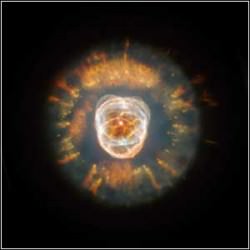 NGC 2392 is so complex that it is not yet fully understood. We know the glowing gases are the outer layers of its central star, shed 10,000 years ago, while the inner ribbons of light (called filaments) are areas where particles are being pushed away by the strong stellar wind. Even now, we still can’t quite explain the unusual outer filaments! It won’t look like a Hubble image in your telescope, but you can still marvel at a unique mystery—seeing its light as it was when the first ‘‘physicists’’ began using the first ‘‘computer’’—the newly invented abacus!
NGC 2392 is so complex that it is not yet fully understood. We know the glowing gases are the outer layers of its central star, shed 10,000 years ago, while the inner ribbons of light (called filaments) are areas where particles are being pushed away by the strong stellar wind. Even now, we still can’t quite explain the unusual outer filaments! It won’t look like a Hubble image in your telescope, but you can still marvel at a unique mystery—seeing its light as it was when the first ‘‘physicists’’ began using the first ‘‘computer’’—the newly invented abacus!
Now, don’t forget… Before the dawn arrives, Comet Lulin will meet with Saturn! Because the comet doesn’t stop moving and we all live in different time zones, the position will be slightly different for each observer around the world, but the Universal Date you’ve been waiting for is about to happen….
Until next week? Dreams really do come true when you keep on reaching for the stars!
This week’s awesome images are: Sakurai’s Object (press release photo), NGC 2420 (credit—Palomar Observatory, courtesy of Caltech), New Moon in Old Moon’s Arms – Jarle Aasland (APOD), Comet Locator Chart (credit – Chris Peet, courtesy of Heavens-above.com), Illustration of the Hyades Cluster (generated image), Area of Sigma 1 and Sigma 2 Tauri (credit—Palomar Observatory, courtesy of Caltech), Dolidze 22 and Collinder 91 (credit—Palomar Observatory, courtesy of Caltech), Pierre Janssen (historical image), M93 (credit—Palomar Observatory, courtesy of Caltech) and NGC 2392 (credit—Hubble Space Telescope). We thank you so much!
The Telescope Tackle Box – Celestron 94303 Accessory Kit
It’s been a few months since I’d reviewed a product, not because there isn’t anything new out there – but because I like things I can get excited about. Sure, I love fine, expensive optics, exotic telescopes and tech toys, but isn’t the whole point of asking for a product to use and abuse to give you an idea of what’s worth your hard-earned money and what isn’t? Yeah, I thought so, too. That’s why when I began researching Celestron products for “Guide To Space”, I knew I had to get my hands on one these to check out…
While the little kid in me still loves to get packages in the mail, the astronomer in me loves to open them up and see a brushed aluminum case inside the cardboard box even more. For those of us into the telescope game, we treasure cases of any kind and I have a wide collection of them – from discarded make-up kits to plastic power tool castoffs. I’ve found the object is to protect my equipment. While it doesn’t matter if one of my old sets of tripod legs fit great in an old tent pole bag, I’ve noticed it sure makes my heart beat a lot quicker if the case is shiny and has the manufacturer logo emblazoned on the front!
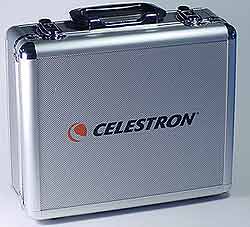 I wasn’t disappointed when I opened it either. The aluminum accessory case is well constructed with reinforced edges and corners, the hinges operate smoothly, the handle isn’t going to just come off and the latches are secure. Inside is lined with dense foam with circular cut outs for the included eyepieces with room for more and a rectangular cut out for the filters in their cases. First test? Ooops. I just dropped it from a height of about a meter and a half onto a hard surface and it didn’t pop open. Second test? I could set it on a hard surface and open it up and it didn’t flop over. Third test? Yeah. Everything inside was still where it was supposed to be! So far… So good.
I wasn’t disappointed when I opened it either. The aluminum accessory case is well constructed with reinforced edges and corners, the hinges operate smoothly, the handle isn’t going to just come off and the latches are secure. Inside is lined with dense foam with circular cut outs for the included eyepieces with room for more and a rectangular cut out for the filters in their cases. First test? Ooops. I just dropped it from a height of about a meter and a half onto a hard surface and it didn’t pop open. Second test? I could set it on a hard surface and open it up and it didn’t flop over. Third test? Yeah. Everything inside was still where it was supposed to be! So far… So good.
There’s a very good reason why I’ve referred to the Celestron 94303 Eyepiece and Filter Accessory Kit as a “telescope tackle box”. Like the many compartmentalized fishing buddy, this kit contains a wide variety of celestial “lures” that serve an even wider variety of purposes. Let’s take a look at each one and what I encountered over several days and times of viewing different objects:
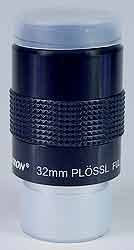 The least magnification factor of all the 1.25″ barrel eyepieces supplied here is the Celestron 32mm plossl. It’s an absolutely classic 4-element design and has a 44 degree apparent field of view, so how does it perform? With my 900mm focal length reflector is providing around 28X magnifying power. This gives outstanding view of wide field subjects such as the Orion nebula complex, the Plieades and combinations of objects such as M81 and M82… including great full disk lunar. The coatings perform very well and so do the optics. I don’t pick up any severe flaws at the edge of the field, the color correction is bright and clean (Orion nebula is grey/green as it should be, and the Plieades are blue) and the Moon doesn’t display reflections. In a 660mm focal length refractor, we’re only getting about 20X magnifying power and the 1525mm focal length reflector gives me about 48X. At all ranges, the Celestron 32mm plossl performs just fine and the eye relief is excellent.
The least magnification factor of all the 1.25″ barrel eyepieces supplied here is the Celestron 32mm plossl. It’s an absolutely classic 4-element design and has a 44 degree apparent field of view, so how does it perform? With my 900mm focal length reflector is providing around 28X magnifying power. This gives outstanding view of wide field subjects such as the Orion nebula complex, the Plieades and combinations of objects such as M81 and M82… including great full disk lunar. The coatings perform very well and so do the optics. I don’t pick up any severe flaws at the edge of the field, the color correction is bright and clean (Orion nebula is grey/green as it should be, and the Plieades are blue) and the Moon doesn’t display reflections. In a 660mm focal length refractor, we’re only getting about 20X magnifying power and the 1525mm focal length reflector gives me about 48X. At all ranges, the Celestron 32mm plossl performs just fine and the eye relief is excellent.
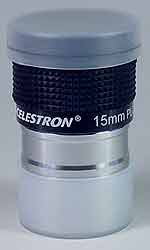 The next up is the Celestron 15mm plossl and a jump to about a 52 degree apparent field of view. First choice is the 900mm focal length reflector and a magnifcation factor of 60X. This is a little bit stronger than what I would have preferred for a mid-range magnification factor. For the 660mm focal length refractor, it provides 44X which is much better. This still keeps the Moon at a full disc and larger objects within range. However, in the 1525mm focal length reflector, it provides just over 100X – but at a great eye relief with bright, non-vignetted edges. This makes the 15mm plossl an exceptional large galaxy study eyepiece and makes small nebula nice and bright. Again, the color correction is outstanding and there are no spurious (optically caused) reflections around bright stars like Sirius.
The next up is the Celestron 15mm plossl and a jump to about a 52 degree apparent field of view. First choice is the 900mm focal length reflector and a magnifcation factor of 60X. This is a little bit stronger than what I would have preferred for a mid-range magnification factor. For the 660mm focal length refractor, it provides 44X which is much better. This still keeps the Moon at a full disc and larger objects within range. However, in the 1525mm focal length reflector, it provides just over 100X – but at a great eye relief with bright, non-vignetted edges. This makes the 15mm plossl an exceptional large galaxy study eyepiece and makes small nebula nice and bright. Again, the color correction is outstanding and there are no spurious (optically caused) reflections around bright stars like Sirius.
 Now for the 9mm Celestron plossl. Into the 900mm focal length reflector it goes. Eye relief is marginal, but it does still carry the nice 52 degree apparent field of view at 100X. It’s showing me the same performance properties of the 17mm in a longer focal length telescope – but with less eye relief. In the 660mm reflector it provides 73X, which means you’re sacrificing some eye relief to get the magnification, but the images are still surprisingly bright and no coma at the edges. In the shorter focal length telescopes, this is a good galaxy study eyepiece and does surprisingly well a small bright nebulae, too. In the 1525 focal length reflector it gives around 170X which makes it just dandy for smacking resolution out of globular clusters and studying galaxy details while still keeping the object bright. This is also a great range for the longer focal length to use for lunar and planetary studies because you’re not hammering the magnification so much that the least atmospheric disturbance is so noticeable.
Now for the 9mm Celestron plossl. Into the 900mm focal length reflector it goes. Eye relief is marginal, but it does still carry the nice 52 degree apparent field of view at 100X. It’s showing me the same performance properties of the 17mm in a longer focal length telescope – but with less eye relief. In the 660mm reflector it provides 73X, which means you’re sacrificing some eye relief to get the magnification, but the images are still surprisingly bright and no coma at the edges. In the shorter focal length telescopes, this is a good galaxy study eyepiece and does surprisingly well a small bright nebulae, too. In the 1525 focal length reflector it gives around 170X which makes it just dandy for smacking resolution out of globular clusters and studying galaxy details while still keeping the object bright. This is also a great range for the longer focal length to use for lunar and planetary studies because you’re not hammering the magnification so much that the least atmospheric disturbance is so noticeable.
 Ready for more? Then let’s go for the Celestron 6mm plossl in the 900mm focal length reflector. This gives 150X magnification factor and no where near the scope’s practical limits. Even though the apparent field of view is still good, the eye relief is beginning to really suffer. However, I am quite surprised to see the image remains fairly bright on galactic studies. In the 660mm focal length refractor I’m getting 110X, and while this scope isn’t a “light bucket” this magnification range make the scope rather exceptional on pretty double stars, lunar and planetary details. For example, Iota Orionis was easily split and very beautiful, it was possible to see glimpses of the Cassini division in Saturn’s rings and Comet Lulin filled the field! As far as performance is concerned, put the 6mm plossl in the 1525mm focal length reflector and you get 254X. Go on… Take a look at the Trapezium. You’ll see red and blue stars!
Ready for more? Then let’s go for the Celestron 6mm plossl in the 900mm focal length reflector. This gives 150X magnification factor and no where near the scope’s practical limits. Even though the apparent field of view is still good, the eye relief is beginning to really suffer. However, I am quite surprised to see the image remains fairly bright on galactic studies. In the 660mm focal length refractor I’m getting 110X, and while this scope isn’t a “light bucket” this magnification range make the scope rather exceptional on pretty double stars, lunar and planetary details. For example, Iota Orionis was easily split and very beautiful, it was possible to see glimpses of the Cassini division in Saturn’s rings and Comet Lulin filled the field! As far as performance is concerned, put the 6mm plossl in the 1525mm focal length reflector and you get 254X. Go on… Take a look at the Trapezium. You’ll see red and blue stars!
 Last, but not least is the Celestron 4mm plossl. In the 900mm focal length reflector you get 225X. This is hammer time for lunar and planetary details – as well as double stars. The eye relief isn’t any worse than the 6mm, but you’re pushing the magnification to the point where the least atmospheric disturbance really begins to show. In the 1525mm reflector, this means 381X and just around half of what its practical magnification limits are. At this point, you are also dimming the image as well. In the 660mm focal length refractor it’s producing 165X and pushing it to its limits. While I’m getting nice airy disc, it just seems very “on the edge”.
Last, but not least is the Celestron 4mm plossl. In the 900mm focal length reflector you get 225X. This is hammer time for lunar and planetary details – as well as double stars. The eye relief isn’t any worse than the 6mm, but you’re pushing the magnification to the point where the least atmospheric disturbance really begins to show. In the 1525mm reflector, this means 381X and just around half of what its practical magnification limits are. At this point, you are also dimming the image as well. In the 660mm focal length refractor it’s producing 165X and pushing it to its limits. While I’m getting nice airy disc, it just seems very “on the edge”.
When it comes to the eyepieces included in the Celestron 94303 Eyepiece and Filter Accessory Kit, I found all of them to perform very well in every telescope I chose. You must remember the magnification factor of any eyepiece is the focal length of the telescope divided by the focal length of the eyepiece – and that every telescope has a practical magnification limit. You must also consider that while the same eyepiece performing at 100X in one telescope, will not perform like a similar 100X power in another telescope because each telescope is capable of different resolution factors and light gathering ability. With this in mind, know that each one of these eyepieces normally retail for around $45 a piece, are threaded for filters, have protective caps, produce a nice, flat field with no screaming vignetting, good color correction, excellent contrast and decent eye relief. In my book, that makes them a valuable asset to any eyepiece collection.
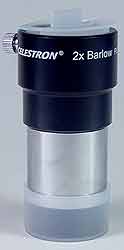 How about the barlow lens? Yes! There’s a 2X Celestron Barlow Lens here, too! For those of you who have never used a barlow, it’s a down and dirty, quick and convenient way of doubling the magnification power of any eyepiece – and preserving the eye relief. For example, and without being redundant, you can take any of the eyepieces reviewed above and simply double the magnification power when you place the barlow lens in the focuser before the eyepiece. In certain circumstances, this doesn’t seem to make a whole lot of sense to me because the wide variety of eyepieces included drop almost accordingly, but there is a marginal difference. Considering the barlow is an exceptionally useful tool to have in any astronomy kit and the fact that you might prefer the magnification factor and eye relief of say… the 15mm coupled with the barlow over the 8mm… it’s great that it’s in there! At around $40, the fully multicoated lenses certainly won’t cause any image degradation and the barlow just might be your cup of tea!
How about the barlow lens? Yes! There’s a 2X Celestron Barlow Lens here, too! For those of you who have never used a barlow, it’s a down and dirty, quick and convenient way of doubling the magnification power of any eyepiece – and preserving the eye relief. For example, and without being redundant, you can take any of the eyepieces reviewed above and simply double the magnification power when you place the barlow lens in the focuser before the eyepiece. In certain circumstances, this doesn’t seem to make a whole lot of sense to me because the wide variety of eyepieces included drop almost accordingly, but there is a marginal difference. Considering the barlow is an exceptionally useful tool to have in any astronomy kit and the fact that you might prefer the magnification factor and eye relief of say… the 15mm coupled with the barlow over the 8mm… it’s great that it’s in there! At around $40, the fully multicoated lenses certainly won’t cause any image degradation and the barlow just might be your cup of tea!
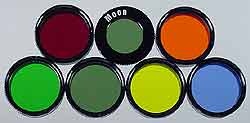 Now for the filters… 1.25″ glass telescope filters included with the Celestron Eyepiece and Filter Kit include Kodak Wratten #12, #21, #25, #56, #58A, and #80A. That’s awesome… But what do they do? First, let’s start with how they work. On the open end of the eyepiece barrel you’re going to find threads and these filters simply screw into these threads. What’s more, you’ll find the filter cells are also threaded to be connected to each other, so it is possible to “stack” filters. Using color filter with a telescope takes experimentation, and while you can recommend what each one is used for – only you can ultimately decide what works best for you! Each individual filter comes packaged in its own plastic padded case and they retail for around $15 a piece.
Now for the filters… 1.25″ glass telescope filters included with the Celestron Eyepiece and Filter Kit include Kodak Wratten #12, #21, #25, #56, #58A, and #80A. That’s awesome… But what do they do? First, let’s start with how they work. On the open end of the eyepiece barrel you’re going to find threads and these filters simply screw into these threads. What’s more, you’ll find the filter cells are also threaded to be connected to each other, so it is possible to “stack” filters. Using color filter with a telescope takes experimentation, and while you can recommend what each one is used for – only you can ultimately decide what works best for you! Each individual filter comes packaged in its own plastic padded case and they retail for around $15 a piece.
When it comes to #12 Yellow, you’ll find it reduces light transmission to 74%, thus helping to reduce glare around bright subjects such as the planets and Moon. It is known for enhancing orange and yellow features, and contrasting blue and green – such as those on Jupiter and Saturn – as well as giving nice contrast on lunar subjects. #21 Orange drops light transmission to 46% and blocks transmission of blue-green wavelengths. This means you’re going to enjoy this particular filter for seeing edge of maria detail on Mars (when Mars is close enough and big enough to enjoy) and it will improve some details in the equatorial belts on Jupiter and definitely make Saturn’s planet on the rings and rings on the planet shadow more defined. #25 Red only allows 14% of the light to come through, and this dandy little filter works well with large aperture scopes for seeing Mars polar caps and really rocks for digging unusual details off the lunar surface and helping to pick out Venus phases. #56 Light Green is a great all-purpose filter, allowing 53% transmission and works very well with Mars polar caps, Jupiter details and fine lunar details. It’s also a great “stacker” to enhance other filters, too. #58A Green gives 24% light transmission and it’s the world’s best set of telescope “sunglasses”. While it will help pick out odd ball features on Saturn, what you’ll find you use it for most is turning down the photons when observing the Moon and Venus! It also works very well in conjunction with a white light solar filter to help relieve eye strain while sketching. #80A Medium Blue is also another “classic” color filter. It provides 32% light transmission and although it will dim out other details, you’ll find it really helps when it comes to spotting the Red Spot and shadow transit events on Jupiter… and can even help distinguish differentiations in Saturn’s cloud patterns. This particular filter makes long-term lunar studies very eye friendly!
 Last, but not least? The neutral density filter. Like its predecessors, it retails for around $15, is threaded on both sides, made from high quality optical glass, fully coated and has about a 13% transmission factor. What makes it different is 0.9 density, which means it’s reducing glare while transmitting light in a uniform manner across the entire spectrum. While it appears to have a gray color – its color isn’t affecting the wavelengths of light. That makes the neutral density filter an exceptional tool to have in your kit, because it can be used to help “tone down” disparate double stars, take the edge off the Moon when watching an occultation, shave some of the light off Venus, enhance bright stars, and become a lunar, solar and planetary observer’s best friend. While it is often simply just called a “Moon Filter”, you’ll find that you’ll use this particular little disc more than any other over the years. So often, in fact, that you may often wonder why that galaxy looks so dim only to discover you’ve forgotten to take it out of your favorite eyepiece!
Last, but not least? The neutral density filter. Like its predecessors, it retails for around $15, is threaded on both sides, made from high quality optical glass, fully coated and has about a 13% transmission factor. What makes it different is 0.9 density, which means it’s reducing glare while transmitting light in a uniform manner across the entire spectrum. While it appears to have a gray color – its color isn’t affecting the wavelengths of light. That makes the neutral density filter an exceptional tool to have in your kit, because it can be used to help “tone down” disparate double stars, take the edge off the Moon when watching an occultation, shave some of the light off Venus, enhance bright stars, and become a lunar, solar and planetary observer’s best friend. While it is often simply just called a “Moon Filter”, you’ll find that you’ll use this particular little disc more than any other over the years. So often, in fact, that you may often wonder why that galaxy looks so dim only to discover you’ve forgotten to take it out of your favorite eyepiece!
 All in all, if you were to purchase each piece of the Celestron 94303 separately, you’d have about $365 in all of these cosmic lures. So, what does the Celestron Eyepiece and Filter Accessory Kit retail for? Try $139 plus shipping. Sure, you could go fishing for the stars with just the eyepieces included with your telescope and you’ll catch them… But sooner or later, you’re going to want to start adding other things to your telescope tackle box – and lasting value and practicality are going to be a point to consider. While these aren’t “prestige” products, they are well constructed, optically well above satisfactory for the price and one of the best daggone values I’ve seen in a long, long time…
All in all, if you were to purchase each piece of the Celestron 94303 separately, you’d have about $365 in all of these cosmic lures. So, what does the Celestron Eyepiece and Filter Accessory Kit retail for? Try $139 plus shipping. Sure, you could go fishing for the stars with just the eyepieces included with your telescope and you’ll catch them… But sooner or later, you’re going to want to start adding other things to your telescope tackle box – and lasting value and practicality are going to be a point to consider. While these aren’t “prestige” products, they are well constructed, optically well above satisfactory for the price and one of the best daggone values I’ve seen in a long, long time…
Way to go, Celestron…
My many thanks to Oceanside Photo and Telescope for once again providing us with a review product. It is very appreciated. I encourage all readers if you chose to purchase this kit from OPT, to be sure to place “Universe Today” in the club affiliation section when ordering to receive a discount on your final bill.
V is For Valentine… V838
[/caption]
And the V we’re taking a stereo look at on Valentine’s Day is V838 Monocerotis – an unusual “light echo” from a variable star. If you’re curious to know more about what you’re looking at, then prepare to take a 20,000 light year journey across space and step inside…
Like all our our “stereo” image produced for UT by Jukka Metsavainio, two versions are presented here. The one above is parallel vision – where you relax your eyes and when you are a certain distance from the monitor screen the two images will merge into one to produce a 3D version. The second – which appears below – is crossed vision. This is for those who have better success crossing their eyes to form a third, central image where the dimensional effect occurs. Jukka’s visualizations of what Hubble images would look like if we were able to see them in dimension come from studying the object, its known field star distances and the different wavelengths of light. Are you ready to “cross” the boundary? Then let’s rock…
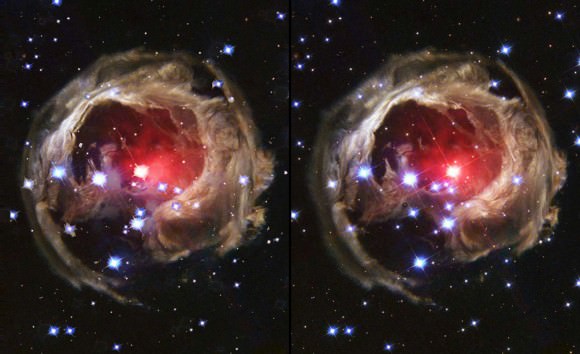
When you’re ready to come back to your seat, let’s talk just a little bit about what V838 Monocerotis is and what we currently know about it.
The primary source of light that you’re seeing in here comes from a variable star – the 838th variable star discovered in the constellation of Monocerotis – which underwent a very strange reaction early in 2002. At first astronomers believed it to be a pretty normal nova event, but it didn’t take long to realize this was something altogether different than anything they’d ever witnessed.
When it first began to brighten on January 10, 2002, the light curve measurements began. These graphs show the intensity of light as a function of time – and they came back as ordinary… a white dwarf shedding accumulated hydrogen gas from its binary neighbor. By February 6th, it had reached its maximum visual brightness and started to dim again, just as expected – but only weeks later the infrared wavelength began to do some very strange things – it brightened unexpectedly and did it again just a few more weeks later! This was something astronomers had simply never witnessed…
According to Howard Bond; “Some classes of stars, including novae and supernovae, undergo explosive outbursts that eject stellar material into space. In 2002, the previously unknown variable star V838 Monocerotis brightened suddenly by a factor of ~104. Unlike a supernova or nova, it did not explosively eject its outer layers; rather, it simply expanded to become a cool supergiant with a moderate-velocity stellar wind. Superluminal light echoes were discovered as light from the outburst propagated into the surrounding, pre-existing circumstellar dust. At its maximum brightness (it) was temporarily the brightest star in the Milky Way. The presence of the circumstellar dust implies that previous eruptions have occurred, and spectra show it to be a binary system. When combined with the high luminosity and unusual outburst behaviour, these characteristics indicate that V838 Mon represents a hitherto unknown type of stellar outburst, for which we have no completely satisfactory physical explanation.”
At the time, V838 expanded in size to the point where it would have filled our solar system to the size of Jupiter’s orbit and output a million times the luminosity of our own Sun – changes that happened in an abnormal time span of just months. Since science did have pre-eruption photographs, V838 was thought to be an under luminous F-type dwarf – much like Sol – which deepened the mystery even further. Just what could cause it to go against the laws of thermodynamics?
According to R. Tylenda; “The eruption phase, which lasted till mid-April 2002, resulted from a very strong energy burst, which presumably took place in last days of January at the base of the stellar envelope inflated in pre-eruption. The burst produced an energy wave, which was observed as a strong luminosity flash in the beginning of February, followed by a strong mass outflow in form of two shells, which was observed as an expanding photosphere in later epochs. In mid-April, when the outflow became optically transparent and most of its energy radiated away, the object entered the decline phase during which V838 Mon was evolving along the Hayashi track. This we interpret as an evidence that the main energy source during decline was due to gravitational contraction of the object envelope inflated in eruption. Late in 2002 a dust formation started in the expanding shells which gave rise to a strong infrared excess observed in 2003.”
Since then we’ve learned the V838 eruptive star may have just been entering the main sequence at the time, and we also know it has a B-type companion that’s also just come aboard the main sequence train. This type of information doesn’t add up to a nova event which occurs to older, white dwarfs… even though it may be something we don’t yet understand. It’s possible that V838 Monocerotis may be a post-asymptotic giant branch star – about to end – but again, it doesn’t fit the spectral patterns. According to some evidence, V838 Monocerotis may be a very massive supergiant that experience “carbon flash”… making their way towards the Wolf-Rayet star end of the chapter. It’s possible that the event could have been a “mergeburst” – where a main sequence and pre-main sequence star combined forces – or even a planetary captured event which triggered deuterium fusion.
And maybe we’ll never know in our lifetimes…
No matter if we understand precisely what created it or not, we can still enjoy the wonderful “light echo” produced by V838 Monocerotis, imaged by the Hubble Telescope and visualized for dimension by Jukka. He understands how the light reflects from clouds of interstellar matter between the star and point of the observer. He knows which wavelengths arrived into the camera lens first and which arrived last…
And we’re grateful to have the chance to look straight into the “heart” of this unusual phenomena!
My many thanks once again to Jukka Metsavainio of Northern Galactic for his artistry and we look forward to the next installment!
Weekend SkyWatcher’s Forecast – February 13-15, 2009
Greetings, fellow SkyWatchers! With the Moon gone from the early evening skies and the weather beginning to warm for northern climes, isn’t it about time you at least took a pair of binoculars out and scanned the skies with me? Some of mankind’s greatest astronomers were born over the next three days, included J.L.E. Dreyer, Fritz Zwicky, William Pickering and Galileo Galilei! Although our weekend targets are simple and you’ve probably already seen them before – how long has it been since you’ve last looked? Or tried with alternative sized optics? Ah… Yes. You begin to see the light! Come on. Dust those old binoculars off and head out into the back yard. I’ll be waiting…
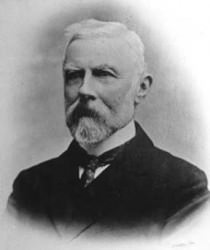 Friday, February 13, 2009 – A bad luck day? Not hardly. It was rather fortunate, because Johan Ludvig Emil Dreyer, was born on this date in 1852. At age 30, Danish astronomer Dreyer became director of the Armagh Observatory—not a grand honor, considering the observatory was so broke it couldn’t afford to replace its equipment. Like all good directors, Dreyer somehow managed to get a new 10″ refractor but no funds for an assistant to practice traditional astronomy. However, J.L.E. was dedicated and within 6 years had compiled all observations known to him into one unified work called the New General Catalogue of Nebulae and Clusters of Stars (NGC). Originally containing 7,840 objects, and supplemented in 1895 and 1908 with another 5,386 designations, the NGC remains the standard reference catalog. Although Dreyer’s personal observations included such nebulous descriptions as ‘‘a vault of stars,’’ modern astronomers continue to use his abbreviations as a kind of shorthand.
Friday, February 13, 2009 – A bad luck day? Not hardly. It was rather fortunate, because Johan Ludvig Emil Dreyer, was born on this date in 1852. At age 30, Danish astronomer Dreyer became director of the Armagh Observatory—not a grand honor, considering the observatory was so broke it couldn’t afford to replace its equipment. Like all good directors, Dreyer somehow managed to get a new 10″ refractor but no funds for an assistant to practice traditional astronomy. However, J.L.E. was dedicated and within 6 years had compiled all observations known to him into one unified work called the New General Catalogue of Nebulae and Clusters of Stars (NGC). Originally containing 7,840 objects, and supplemented in 1895 and 1908 with another 5,386 designations, the NGC remains the standard reference catalog. Although Dreyer’s personal observations included such nebulous descriptions as ‘‘a vault of stars,’’ modern astronomers continue to use his abbreviations as a kind of shorthand.
Honor Dreyer tonight by discovering one of his catalog objects suited for all optics – NGC2287.
Located about two finger-widths south of Alpha Canis Majoris (RA 06 46 00 Dec -20 46 00), only an open cluster this bright could stand up against brilliant Sirius. From a dark-sky location, your unaided eye can even spot this magnitude 4.5 “star vault” as a hazy patch. Aristotle saw it as early as 325 BC! Officially discovered by Hodierna, we know it best by the designation Messier Object 41. Even from 2,300 light-years away, the cluster’s brightest star, an orange giant, stands out clearly from the stellar nest. With large aperture, you’ll notice other K-type stars, all very similar to Sol. Although small scopes and binoculars won’t reveal too much color, you might pick up on the blue signature of young, hot stars. NGC 2287 could be anywhere from 190 to 240 million years old, but its stars shine as brightly now as they did in Aristotle’s day. . .and Dreyer’s!
Saturday, February 14, 2009 – Happy Valentine’s Day! On this date in 1747, astronomer James Bradley presented his evidence of Earth’s wobble, called nutation. The study took 19 years, but won Bradley the Copley Medal! In 1827, George Clark was born. The name might not ring a bell, but it was indeed a bell—melted down—that he used to create his first brass telescope. George’s family went on to produce the finest—and largest—telescopes of their time.
 In 1898 crabby astronomer Fritz Zwicky came along, his name synonymous with the theory of supernovae. The Swiss-born Caltech professor was also a salty character, often intimidating his colleague Walter Baade and referring to others as ‘‘spherical bastards.’’ Although Zwicky was difficult to work with, he was also brilliant—predicting the phenomenon of gravitational lensing.
In 1898 crabby astronomer Fritz Zwicky came along, his name synonymous with the theory of supernovae. The Swiss-born Caltech professor was also a salty character, often intimidating his colleague Walter Baade and referring to others as ‘‘spherical bastards.’’ Although Zwicky was difficult to work with, he was also brilliant—predicting the phenomenon of gravitational lensing.
Tonight we’ll look at a supernova remnant as we venture to the Crab Nebula. Finding M1 is easy: it can be seen with as little as 7X magnification. Locate Zeta Tauri (about halfway between Orion’s ‘‘head’’ and the southernmost bright star in Auriga) and aim about 1 degree northwest (RA 05 34 31 Dec -22 00 52).
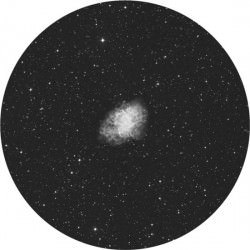 Viewing M1 with small optics helps to understand why Charles Messier decided to compile his famous catalog. Unaware of its earlier discovery, Messier located a fuzzy object near the ecliptic and assumed it was the return of Halley’s Comet. Considering his primitive telescope, we can’t fault his observation. But Chuck was a good astronomer. When he realized the object wasn’t in motion, he began compiling a log of things not to be confused with comets—the famous Messier objects. Enjoy looking at this spectacular deep-sky jewel, and we’ll study it in depth another time. Of course, Zwicky would have cursed me for saying that observing without science is an ‘‘empty brain exercise and therefore a waste of time.’’ But on the date of his birth, I took his advice. . . ‘‘Give me a topic and I’ll give you an idea!’’
Viewing M1 with small optics helps to understand why Charles Messier decided to compile his famous catalog. Unaware of its earlier discovery, Messier located a fuzzy object near the ecliptic and assumed it was the return of Halley’s Comet. Considering his primitive telescope, we can’t fault his observation. But Chuck was a good astronomer. When he realized the object wasn’t in motion, he began compiling a log of things not to be confused with comets—the famous Messier objects. Enjoy looking at this spectacular deep-sky jewel, and we’ll study it in depth another time. Of course, Zwicky would have cursed me for saying that observing without science is an ‘‘empty brain exercise and therefore a waste of time.’’ But on the date of his birth, I took his advice. . . ‘‘Give me a topic and I’ll give you an idea!’’
 Sunday, February 15, 2009 – Are you ready to do a little IYA 2009 outreach? Then start now. This date’s astronomical births begin in 1564 with Galileo Galilei—pioneer of physics and astronomy—who didn’t invent the telescope but certainly perfected it. Arrested for heresy, Galileo entreated fellow scientists to discover the universal truths for themselves. His cry was ignored. To his friend, Johannes, he wrote: ‘‘I wish, my dear Kepler, that we could have a good laugh together at the extraordinary stupidity of the mob. What do you think of the foremost philosophers of this University? In spite of my oft-repeated efforts and invitations, they have refused, with the obstinacy of a glutted adder, to look at the planets or Moon or my telescope.’’
Sunday, February 15, 2009 – Are you ready to do a little IYA 2009 outreach? Then start now. This date’s astronomical births begin in 1564 with Galileo Galilei—pioneer of physics and astronomy—who didn’t invent the telescope but certainly perfected it. Arrested for heresy, Galileo entreated fellow scientists to discover the universal truths for themselves. His cry was ignored. To his friend, Johannes, he wrote: ‘‘I wish, my dear Kepler, that we could have a good laugh together at the extraordinary stupidity of the mob. What do you think of the foremost philosophers of this University? In spite of my oft-repeated efforts and invitations, they have refused, with the obstinacy of a glutted adder, to look at the planets or Moon or my telescope.’’
The birth of lunar and planetary observer William Pickering followed in 1858. During Pickering’s professional years at Harvard, he noted that the entire constellation of Orion is encased in faint nebulosity. Later verified by E.E. Barnard, this nebula is now known as Barnard’s Loop.
With a very dark sky and excellent transparency, you can trace the ‘‘Loop’’ with binoculars. The area is so large and it’s pointless to provide coordinates, but the brightest portion extends eastward between Alpha and Kappa. Because the Orion complex contains so many rapidly evolving stars, it stands to reason a supernova has occurred there. Barnard’s Loop is probably the ancient shell leftover from such a cataclysmic event. If taken as a whole, it would encompass 10 degrees of sky! More difficult for Northern Hemisphere viewers is IC 2118, a huge reflection nebula west of Rigel known as the ‘‘Witch Head.’’ Once photographed by Pickering, IC 2118 is more sensitive to film than to the eye,
but that doesn’t mean you can’t see it. Sky conditions are the decisive factor, so look closely around the eastern edge where the fueling stars are brightest. You just might surprise yourself!
Until next week? Dreams really do come true when you keep on reaching for the stars!
This week’s awesome photos are: J.L.E. Dreyer (historical image), NGC 2287: M41 (credit—Palomar Observatory, courtesy of Caltech), Fritz Zwicky (historical image), Messier Object 1 (credit—Palomar Observatory, courtesy of Caltech), Galileo (historical image) and Eastern edge of IC 2118 (credit—Palomar Observatory, courtesy of Caltech).
IYA 2009 – Brian Sheen Reports on “Canoe Africa”
[/caption]
Back in September of last year, UT reported on one of our intrepid readers who was about to embark on a most ambitious journey to promote the International Year of Astronomy in “Canoe Africa“. For those of you who follow BBC SW Spotlight or Radio Cornwall, you might already know about Brian Sheen’s African astronomy education adventures – but he’s taken this special opportunity to share his story with Universe Today. Grab a paddle and let’s ride…

 Lecturing opportunities at the local colleges and universities were organised by our hosts the Scouts of Sierra Leone. We were able to use the solar scope PST to good effect and the meteorite samples – thanks Tammy – were studied with enthusiasm. During the evening sessions the Sky Scout was extremely useful giving those who had looked up and wondered the answer to at least some of their questions. Away from the kit I was asked some very searching questions – many philosophical. One of the centres we worked with was developing a UV water treatment that was actually free to use. Well or river water was placed in plastic soft drink bottles (label removed) and then laid down in the Sun and let the UV emissions do the rest. The organisers we interested to learn that at sunspot minimum solar UV levels were about 50% of a few years before.
Lecturing opportunities at the local colleges and universities were organised by our hosts the Scouts of Sierra Leone. We were able to use the solar scope PST to good effect and the meteorite samples – thanks Tammy – were studied with enthusiasm. During the evening sessions the Sky Scout was extremely useful giving those who had looked up and wondered the answer to at least some of their questions. Away from the kit I was asked some very searching questions – many philosophical. One of the centres we worked with was developing a UV water treatment that was actually free to use. Well or river water was placed in plastic soft drink bottles (label removed) and then laid down in the Sun and let the UV emissions do the rest. The organisers we interested to learn that at sunspot minimum solar UV levels were about 50% of a few years before.
 After our shakedown period we crossed the border into Guinea and on to the headwaters of the Niger at Faranah. We were hosted by the local Scouts, who had arranged for a boat builder to build a plank canoe (a modern version of the dugout) to our specification. This is a type of canoe used throughout Guinea by local fishermen. The canoe was built in only four days and we were off into the remotest part of the journey an almost uninhabited region which would take 10 days to paddle with no opportunity to buy food or other supplies. Some nights camping out we could see meteors reasonably often – too many to be sporadics and wrong time for a major shower. Checking with David Levy’s book “Guide to Observing Meteor Showers” it seems likely that I was seeing the minor shower – Nu Orionids peaking Nov 28th.
After our shakedown period we crossed the border into Guinea and on to the headwaters of the Niger at Faranah. We were hosted by the local Scouts, who had arranged for a boat builder to build a plank canoe (a modern version of the dugout) to our specification. This is a type of canoe used throughout Guinea by local fishermen. The canoe was built in only four days and we were off into the remotest part of the journey an almost uninhabited region which would take 10 days to paddle with no opportunity to buy food or other supplies. Some nights camping out we could see meteors reasonably often – too many to be sporadics and wrong time for a major shower. Checking with David Levy’s book “Guide to Observing Meteor Showers” it seems likely that I was seeing the minor shower – Nu Orionids peaking Nov 28th.
 The biggest threat, apart from the mosquitoes, came from the big beast of the jungle the hippo. We saw one in the river and tiptoed past him and camped a few miles down stream. It was one those places where it was possible to sleep with out a mosquito net or tent. Looking south we were able to see Orion rise on his back stand up and lie down in the west. As it was dark I had a go at counting the stars inside the square of Orion I reached 30 excluding the Belt and Sword. This gives visible stars down to magnitude 6. Beats counting sheep! Then we heard the unmistakeable sound of a hippo grunting in the river just 20 metres away! We were possibly camping on his get out point! A couple more logs on the fire kept him at bay and eventually he moved back up stream.
The biggest threat, apart from the mosquitoes, came from the big beast of the jungle the hippo. We saw one in the river and tiptoed past him and camped a few miles down stream. It was one those places where it was possible to sleep with out a mosquito net or tent. Looking south we were able to see Orion rise on his back stand up and lie down in the west. As it was dark I had a go at counting the stars inside the square of Orion I reached 30 excluding the Belt and Sword. This gives visible stars down to magnitude 6. Beats counting sheep! Then we heard the unmistakeable sound of a hippo grunting in the river just 20 metres away! We were possibly camping on his get out point! A couple more logs on the fire kept him at bay and eventually he moved back up stream.
 In the morning we set off again and the river was pretty easy to paddle until the canoe came to an abrupt halt. Geoff at the stern of the craft flew into the air Mike at the bow shouted hippo and we all ended up in the river. A 3 ton Bull Hippo had hit us like a submarine launched missile. As we are all lifeguards we swam the canoe to side and emptied out. It was too badly damaged to go on so we were forced to walk out of the jungle through razor edged elephant grass considered impenetrable by many. After five days we reached a small village and safety. At many times I felt that we were caught in a 19th century “ripping yarn for boys”. The jungle was very uneven with deep run off channels hidden by the grass. We all fell more than once, however we never even opened a Band Aid in the whole time we were in West Africa.
In the morning we set off again and the river was pretty easy to paddle until the canoe came to an abrupt halt. Geoff at the stern of the craft flew into the air Mike at the bow shouted hippo and we all ended up in the river. A 3 ton Bull Hippo had hit us like a submarine launched missile. As we are all lifeguards we swam the canoe to side and emptied out. It was too badly damaged to go on so we were forced to walk out of the jungle through razor edged elephant grass considered impenetrable by many. After five days we reached a small village and safety. At many times I felt that we were caught in a 19th century “ripping yarn for boys”. The jungle was very uneven with deep run off channels hidden by the grass. We all fell more than once, however we never even opened a Band Aid in the whole time we were in West Africa.
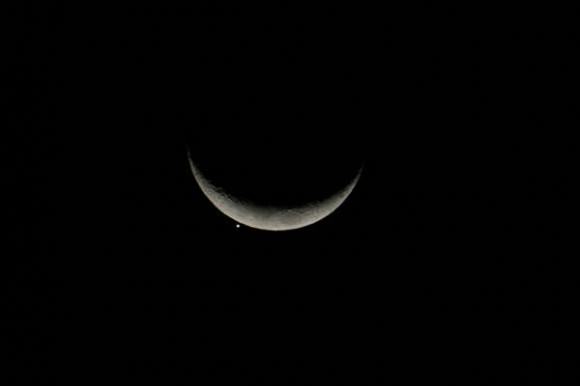
We actually missed one event I had been looking forward to, the occultation of Venus by the Moon, however we felt that saving our lives was even more important! Meanwhile back at the Observatory Paul Hughes took an excellent set of images. The Americans will have to wait until 22nd April for their opportunity to witness this for themselves. (While looking into Elephant Grass I found that it could be used as a bio-fuel so perhaps it has uses after all.) The movements of Jupiter, Venus and the Moon provided good teaching material. As the days went by Jupiter moved further and further towards the west at a given time. It was also moving from west to east against the background stars. Venus on the other hand was climbing in the night sky. Eventually it was over taken by the Moon, the occultation, proving that the Moon too moves from west to east but at a faster rate than the planets. Perhaps the most spectacular view was of the Orion complex containing Betelgeuse, Rigel, Aldabran, Capella, Castor, Pollux, Procyon, Sirius, Canopus and Achernar. Most we can see from the UK but in Africa these stars were much higher and appear much brighter in dark skies.
 Although the European population in Sierra Leone and Guinea is tiny we were given a tremendous welcome from the local people and Scouts everywhere we went. There is a real hunger for knowledge, at the moment they “look up perfect silence at the stars” to quote Walt Whitman and wonder. Astronomers with a good knowledge of Africa could find an open-ended opportunity. In the future, we have a promise made to Bamako University in Mali to meet, and the river between there and Timbuktu runs through the very interesting inland delta also the Dogon people claim special insights into astronomy. Would I go back to the incident site? A filmed reconstruction would be good – any offers? For more information and images check out Roseland Observatory and follow the links.” — Reporting for Universe Today, Brian Sheen, Roseland Observatory, RAS Education Focus Group.
Although the European population in Sierra Leone and Guinea is tiny we were given a tremendous welcome from the local people and Scouts everywhere we went. There is a real hunger for knowledge, at the moment they “look up perfect silence at the stars” to quote Walt Whitman and wonder. Astronomers with a good knowledge of Africa could find an open-ended opportunity. In the future, we have a promise made to Bamako University in Mali to meet, and the river between there and Timbuktu runs through the very interesting inland delta also the Dogon people claim special insights into astronomy. Would I go back to the incident site? A filmed reconstruction would be good – any offers? For more information and images check out Roseland Observatory and follow the links.” — Reporting for Universe Today, Brian Sheen, Roseland Observatory, RAS Education Focus Group.
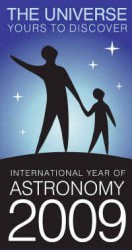 Brian is back home safe again in Cornwall, perhaps no worse for the wear, but definately more full of IYA 2009 adventure and spirit than most of us will ever hope to achieve this year. (For a charming insight on their hippo adventure, be sure to listen to the BBC Audio Interview). The team hopes to revisit the area again next year and we wish them the best. For now, hats off to Brian Sheen and his excellent astronomy outreach work!
Brian is back home safe again in Cornwall, perhaps no worse for the wear, but definately more full of IYA 2009 adventure and spirit than most of us will ever hope to achieve this year. (For a charming insight on their hippo adventure, be sure to listen to the BBC Audio Interview). The team hopes to revisit the area again next year and we wish them the best. For now, hats off to Brian Sheen and his excellent astronomy outreach work!
Australian Wildfire Update
[/caption]
As Nancy reported on February 8th, the wild fires in Australia were not only serious, but out-of-control. While we had a look at satellite imagery, there’s nothing scarier than having it hit close to home and friends… Our friends at Southern Galactic.
As our Universe Today readers well know, our friends “down under” at Southern Galactic imaging are always on top the astronomy game, offering us up exclusive views of astronomy events not found any where else. Like the fire situation which raged in California last year, I watched remotely – curious as to how close it was getting to the observatories, but not knowing from a distance. I sat here in subzero weather watching the snow come down, while half a world away things were far, far different…
I had wondered why things were quiet. Skype was down and I wasn’t seeing a image on the remote scopes. My usual welcome “chat” with Bert was curiously absent, but the reality of what was going on didn’t sink in until now. I was complaining about plowing snow – but I should have been praying for my friends safety. When communications were re-established with Southerngalactic Site 1 telescope hosting facility this morning, Bert Candusio, the Observatory Director, told me about the wicked events which occurred on Saturday, February 7th… the day Victoria suffered under 47 degree Celsius heat with fires that tore through the state.
“We were awoken with radio warnings that a series of fires had taken hold and were running out of control. One fire in particular had caused us concern around 2:00 PM when the areas of Cobaw, Baynton and Pastoria were placed on alert that the fire had travelled 25 kilometers from the Northwest and was now headed towards the southeast in our direction.
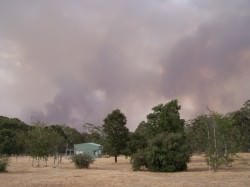
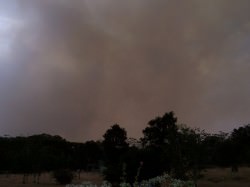
As we were gearing up for what could have been the worst, a sudden southerly wind change from the south began to drive the fire front to the north east and away from the site we were ready to defend. We were fortunate. Others were not.”
With the terrible conflagration passing within 8 kilometers of the Southern Galactic Telescope Hosting Facility, eating ash and breathing smoke clings to Candusio like the remnants of a horrible nightmare. Not only was his life’s work and investment sitting in the line of fire – but his home and loved ones as well. Only hours later, the fire which threatened the facility moved to the Hopetown area further north and is still out of control and the entire northeast and south section of Victoria still remains in danger. At the time of this writing, twelve separate fires continue to threaten lives, homes and property.
To Candusio, February 7 will live forever in his memory, but not as a good one. “To the surviving victims of that day’s terrible events, we extend our hearts and our deepest sympathies to them, their families and for their loved ones that have been lost.”

